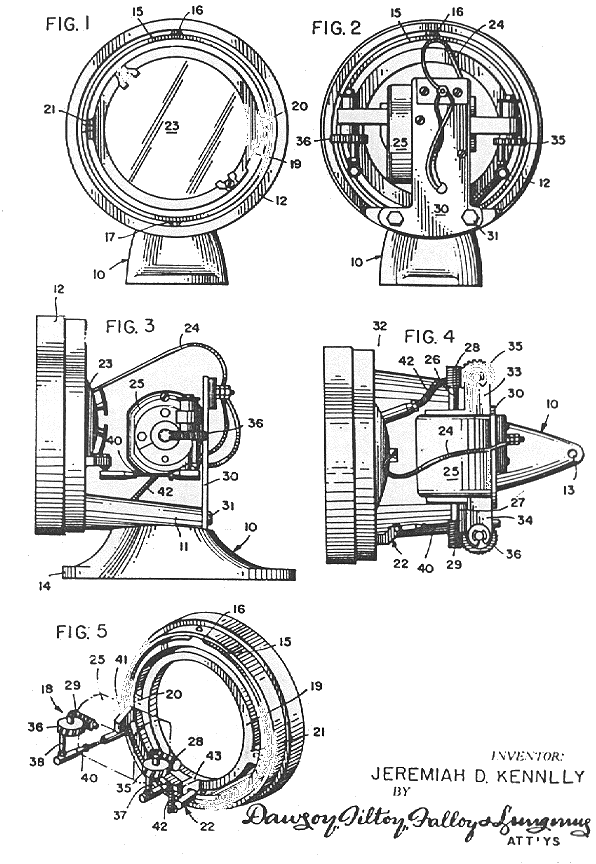This website has been archived from TrainWeb.org/gyra to TrainWeb.US/gyra.
This website has been archived from TrainWeb.org/gyra to TrainWeb.US/gyra.

This invention is an improvement over the inventor's patent of a "figure 8" light., US Pat. 2,510,892. In particular, the improvements include a structural arrrangement which can accomplish the oscillation of the unit's beam, yet is compact to provide a simple, rugged, and easily maintainable (and repairable) structure.
The object of this design was to provide a signal which was particularly adapted for use on
fire engines, ambulances and other public emergency vehicles. It waws also designed for use at
railroad crossings.
There is a plurality of completely independent lights and circuits. If one or more of the light
bulbs on this unit burn out, it will not render the remaining elements inoperative.
Figure 1 is a front elevation view.
Figure 2 is a rear elevational view of the light in Figure 1 - with the protective
housing removed.
Figure 3 is a side elevational view of Figure 2.
Figure 4 is a top plan view of Figure 2 and Figure 3.
Figure 5 is a fragmentary perspective view of the operational portions of the linkages
for effecting the multisinusoidal movement provided in the light unit.
In the illustrations given, the numeral 10 designates generally a base which is adapted
for mounting atop the roof of an emergency vehicle or other prominent position for warning
pedestrians and motorists of the approach of an emergency vehicle.
Providing energy for the oscillating lamp 23 inthe desired pattern, is a motor
25 which includes a pair of shaft extensions at 26 and 27 (see
Figure 4). Each shaft extension 26 and 27 is equipped with a worm
at 28 and 29, these being best illustrated in Figure 5. The motor
25 is rigidly mounted on a generally vertically extending bracket 30 which is
suitably bolted as at 31 to the platform 11. The entire working portion of the
light is quite compact and readily enclosed in a suitable housing 32, a fragment of of
which is seen in Figure 4.
Each end of the motor 25 is equipped with a laterally projecting arm as at
33 and 34 (see Figure 4). Rotatably mounted in each arm
33 and 34, respectively, is a worm gear 35 and 36, with the
respective gears being in engagement with the worms 28 and 29.
As can be seen from Figure 5 , each worm gear 35 and 36 is
equipped with a depending spindle or rod 37 being provided on the worm gear
35, and a rod 38 being provided on the worm gear 36. The linkage
generally designated 18, further includes a linkage member 40 (referring to
Figure 5) which extends between the rod 38 and a rearwardly projecting lug
41 on the outer subframe 15. A linkage member 40 is essentially
straight and develops a sinusoidal left-to-right movement of the lamp 23.
The linkage 22 (Figure 5) differs from the linkage 18 in having a
stepped or offset type of member 42. The linkage member 42 is seen to
extend between rod 37 and a rearwardly extending lug or ear 43 provided on
the inner subframe 19. By the arrangement shown, linkage connection is provided to
the two subframes which are spaced approximately 90° apart so as to power the two subframes
properly, yet the power train is essentially compact with the motor 25, being positioned
almost centrally behind and in close relation with the lamp 23. The separation of the
two linkage systems or power trains make possible ready maintenance as, for example,
lubrication of the various pivotal interconnections between the rod 37 and the ear
43.
In this light unit, gearing of different capacity is employed at 18 and 22.
For example, with gearing at 18 providing only one-sixth the speed of the gearing at
22, three "figure 8s" ("888") will be completed in one cycle (i.e., the inner subframe 19
will go through 3 cycles while the outer subframe 15 goes through one-half an
oscillation. This makes possible a startlingly effective signal light.
| Mars "888" Light: | photos |
|---|